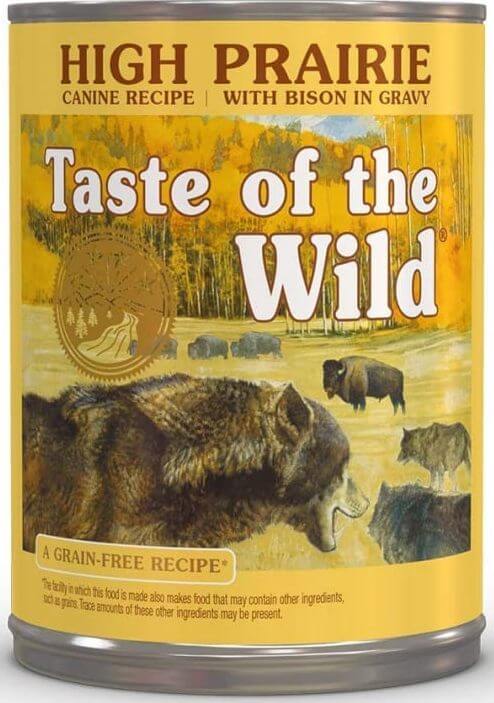
DogFoodAdvisor is reader supported See how
All reviews are 100% impartial but if you buy using links on this page, we may earn a referral fee.
Which Taste of the Wild Wet Recipes Get Our Best Ratings?
Taste of the Wild canned dog food receives the Advisor’s best rating of 5 stars.
The Taste of the Wild product line includes the 5 canned dog foods listed below.
Each recipe includes its AAFCO nutrient profile when available… Growth (puppy), Maintenance (adult), All Life Stages, Supplemental or Unspecified.
Recipe and Label Analysis
Taste of the Wild High Prairie Canine was selected to represent the other products in the line for detailed recipe and nutrient analysis.
Label and nutrient data below are calculated using dry matter basis.
Taste of the Wild High Prairie Canine
Estimated Dry Matter Nutrient Content
Protein
Fat
CarbsCarbohydrates
Beef, lamb broth, beef broth, vegetable broth, lamb liver, bison, dried egg whites, potatoes, peas, dried egg product, potato starch, lamb, venison, ocean fish, guar gum, sunflower oil, natural flavor, tricalcium phosphate, sodium phosphate, salt, calcium carbonate, potassium chloride, inulin, tomatoes, sweet potatoes, blueberries, raspberries, taurine, choline chloride, zinc amino acid chelate, Yucca schidigera extract, iron amino acid chelate, xanthan gum, thiamine mononitrate, natural roasted flavor, vitamin E supplement, copper amino acid chelate, manganese amino acid chelate, sodium selenite, cobalt amino acid chelate, niacin supplement, d-calcium pantothenate, vitamin A supplement, riboflavin supplement, biotin, vitamin B12 supplement, potassium iodide, pyridoxine hydrochloride, vitamin D3 supplement, folic acid
Fiber (estimated dry matter content) = 1%
Red denotes any controversial items
| Estimated Nutrient Content | |||
|---|---|---|---|
| Method | Protein | Fat | Carbs |
| Guaranteed Analysis | 8% | 4% | NA |
| Dry Matter Basis | 44% | 19% | 28% |
| Calorie Weighted Basis | 37% | 39% | 24% |
Ingredient Analysis
The first ingredient in this dog food is beef. Beef is defined as “the clean flesh derived from slaughtered cattle” and includes skeletal muscle or the muscle tissues of the tongue, diaphragm, heart or esophagus.1
Beef is naturally rich in all ten essential amino acids required by a dog to sustain life.
The next three items include lamb, beef and vegetable broths. Broths are of only modest nutritional value. Yet because they add both flavor and moisture to a dog food, they are a common addition component in many canned products.
But if we were to combine all these individual items together and report them as one, that newer combination would almost certainly occupy a higher position on the list — possibly making broth (not meat) the predominant ingredient in this recipe.
The fifth ingredient is lamb liver. This is an organ meat sourced from a named animal and thus considered a beneficial component.
The next ingredient includes bison. Bison is a highly digestible and remarkably lean meat. Like all meats, it is notably rich in all ten amino acids required by a dog to sustain life.
The seventh ingredient lists dried egg whites. Eggs are highly digestible and an excellent source of usable protein.
The eighth ingredient is potato. Potatoes can be considered a gluten-free source of digestible carbohydrates. Yet with the exception of perhaps their caloric content, potatoes are of only modest nutritional value to a dog.
The ninth ingredient includes peas. Peas are a quality source of carbohydrates. And like all legumes, they’re rich in natural fiber.
However, peas contain about 25% protein, a factor that must be considered when judging the meat content of this dog food.
The next ingredient is dried egg product, a dehydrated form of shell-free eggs. Quality can vary significantly. Lower grade egg product can even come from commercial hatcheries — from eggs that have failed to hatch.
In any case, eggs are easy to digest and have an exceptionally high biological value.
From here, the list goes on to include a number of other ingredients.
But realistically, items located this far down the list (other than nutritional supplements) are not likely to affect the overall rating of this TOTW product.
With 5 notable exceptions…
First, sunflower oil is nutritionally similar to safflower oil. Since these oils are high in omega-6 fatty acids and contain no omega-3s, they’re considered less nutritious than canola or flaxseed oils.
Sunflower oil is notable for its resistance to heat damage during cooking.
There are several different types of sunflower oil, some better than others. Without knowing more, it’s impossible to judge the quality of this ingredient.
Next, we find sodium selenite, a controversial form of the mineral selenium. Sodium selenite appears to be nutritionally inferior to the more natural source of selenium found in selenium yeast.
In addition, inulin is a starch-like compound made up of repeating units of carbohydrates and typically sourced from chicory root.
Not only is inulin a natural source of soluble dietary fiber, it’s also a prebiotic used to promote the growth of healthy bacteria in a dog’s digestive tract.
We also note the use of taurine, an important amino acid associated with the healthy function of heart muscle. Although taurine is not typically considered essential in canines, some dogs have been shown to be deficient in this critical nutrient.
Since taurine deficiency appears to be more common in pets consuming grain-free diets, we view its presence in this recipe as a positive addition.
And lastly, this food contains chelated minerals, minerals that have been chemically attached to protein. This makes them easier to absorb. Chelated minerals are usually found in better dog foods.
Nutrient Analysis
Based on its ingredients alone, Taste of the Wild canned dog food looks like an above-average wet product.
The dashboard displays a dry matter protein reading of 44%, a fat level of 19% and estimated carbohydrates of about 28%.
As a group, the brand features an average protein content of 45% and a mean fat level of 21%. Together, these figures suggest a carbohydrate content of 26% for the overall product line.
And a fat-to-protein ratio of about 46%.
Which means this Taste of the Wild product line contains…
Above-average protein. Below-average fat. And below-average carbs when compared to other canned dog foods.
Even when you consider the protein-boosting effect of the peas, this looks like the profile of a wet product containing a significant amount of meat.
Our Rating of Taste of the Wild Wet Dog Food
Taste of the Wild is a grain-free canned dog food using a significant amount of named meats as its dominant source of animal protein, thus earning the brand 5 stars.
Enthusiastically recommended.
More Top Picks
Taste of the Wild Dog Food Recall History
The following automated list (if present) includes all dog food recalls related to Taste of the Wild through July.
- Diamond Dog Food Recall Summary (5/6/2012)
You can view a complete list of all dog food recalls since 2009 here.
Get Free Recall Alerts
Get free dog food recall alerts sent to you by email. Subscribe to The Advisor’s recall notification list.
More Taste of the Wild Brand Reviews
The following Taste of the Wild dog food reviews are also posted on this website:
- Taste of the Wild Ancient Grains Dog Food Review (Dry)
- Taste of the Wild Dog Food Review
- Taste of the Wild Prey Dog Food Review (Dry)
Compare This Dog Food
How does this brand compare with The Dog Food Advisor's most recommended brands?
A Final Word
The Dog Food Advisor does not accept money, gifts, samples or other incentives in exchange for special consideration in preparing our reviews.
However, we do receive a referral fee from online retailers (like Chewy or Amazon) and from sellers of perishable pet food when readers click over to their websites from ours. This helps cover the cost of operation of our free blog. Thanks for your support.
For more information, please visit our Disclaimer and Disclosure page.







